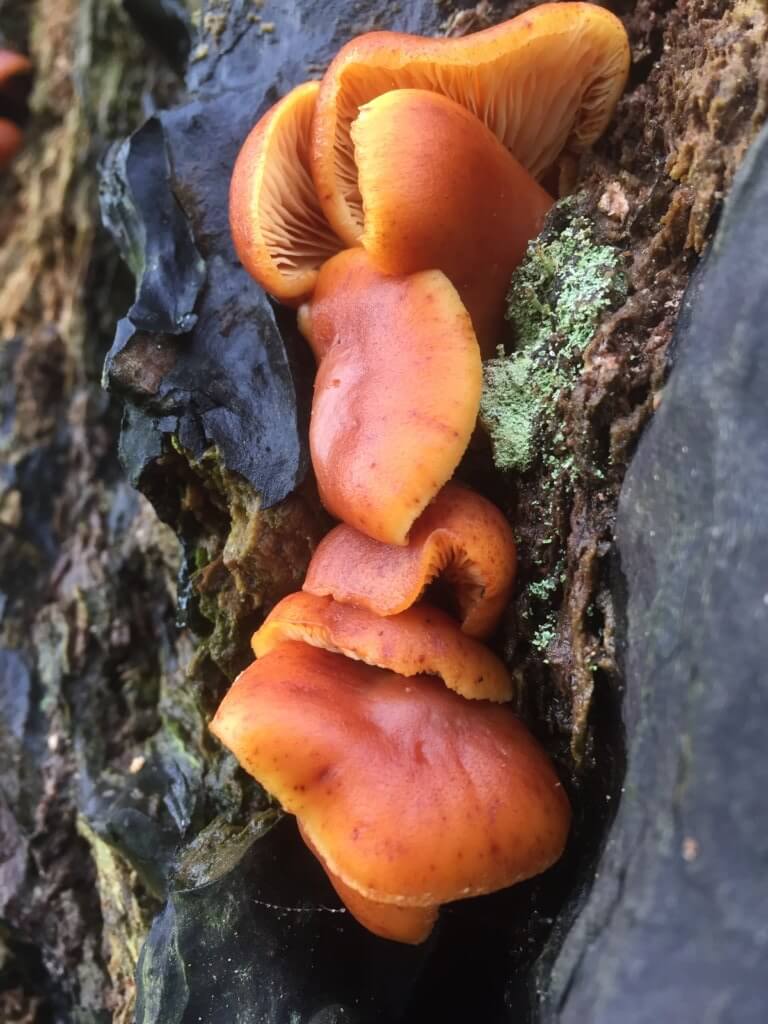
The Velvet Shank is unusual amongst fungi in that it is a true winter species, thriving in the coldest and darkest months of the year. It is named after the velvety texture of the stems, ‘shank’ here referring to these rather than the more usual meaning of ‘leg’ – as in Redshank for example. The scientific name is Flammulina velutipes, the second part again referencing the velvety stems, while the first part means, rather delightfully, ‘little flames’.
This is a species to look out for if you are heading outside for a New Year’s Day walk. It is one of the very few high quality edible species you are likely to find in the dead of winter. Frost kills most fungi but this species can survive being frozen solid for days, patiently biding its time and awaiting the thaw when it can spring back to life and start growing and reproducing once again.
It grows in groups on dead wood, primarily the old stumps of deciduous trees. Elm was a favourite host so there must have been a glut during the years following Dutch Elm Disease. Today, it has to rely on other common deciduous trees. These were found in mid-December on a huge, gnarled Beech trunk, snapped off about 12 feet above the ground. The caps are twisted and distorted, the result of growing within the confines of a deep, narrow fissure within the surface of the tree.
Because they looked so different from the usual shape of this species I wasn’t completely sure of the identification. To double-check I made use of the excellent First Nature website, sending in my photo and receiving a very helpful email back just a few hours later. I also learned from the website that this species is believed to have anti-cancer properties. Apparently Japanese farmers who cultivate a form of this species known as ‘Enokitake’ enjoy lower rates of death from cancer than the national average. If you are sceptical then try to suspend your disbelief just enough to allow the placebo effect to work its magic.
[registration_form]
Another thing learnt. Thanks Ian but will you and Mark allow the venting of this off-topic thought?
Fungi and spleens – they share near contemporary and very belated scientific recognition.
Fungi were separated from plants and gained their own kingdom in the late 1960’s. Their kudos increased even further when their biochemistry was seen to be closer to animals rather than plants. At about the same time, in the early 1960’s, the spleen was reluctantly seen as an important organ and doctors have since become much more respectful of it.
As with fungi, there remains a lot of mystery about the spleen. For example, its ability after trauma, to regrow from small fragments which have managed to embed themselves in other parts of the abdomen. It’s almost as if this organ is its own organism.
In contrast, the placebo effect is at least 150 years older than these two enlightenments.
But enough of Googled history. Instead, here’s to this blog in 2018:
May it shed light where there’s shade. More precisely, may each of its ‘page reads’ turn into a mycelium of spreading information which in turn replicates and regrows throughout the depths of cyberspace. In short, may this blog become its own super-organism.
A Happy and Good Splenic New Year to everyone.